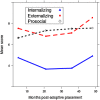Early adversity predicts adoptees' enduring emotional and behavioral problems in childhood - PubMed (original) (raw)
Early adversity predicts adoptees' enduring emotional and behavioral problems in childhood
Amy L Paine et al. Eur Child Adolesc Psychiatry. 2021 May.
Abstract
Children adopted from the public care system are likely to experience a cluster of inter-related risk factors that may place them on a trajectory of mental health problems that persist across the life course. However, the specific effects of putative risk factors on children's mental health post-placement are not well understood. We conducted a prospective, longitudinal study of children placed for adoption between 2014 and 2015 (N = 96). Adoptive parents completed questionnaires at approximately 5, 21, 36, and 48 months post-placement. We used time series analysis to examine the impact of pre-adoptive risk factors [adverse childhood experiences [ACEs], number of moves, days with birth parents and in care] on children's internalizing and externalizing problems, and prosocial behavior over 4 years post-placement. Adoptees' internalizing and externalizing problems remained consistently high over the 4-year study period, but more ACEs predicted increases in internalizing and externalizing problems. Contrary to expectations, more pre-placement moves and time in care predicted fewer problems over time, but exploratory analyses of interactive effects revealed this was only the case in rare circumstances. We identify pre- and post-removal factors that may incur benefits or have a deleterious impact on adoptees' outcomes in post-adoptive family life. Our findings provide knowledge for front-line professionals in the support of adoptive families and underscore the vital need for effective early intervention.
Keywords: Adoption; Childhood; Longitudinal study; Mental health; Risk.
Conflict of interest statement
The authors have no conflict of interest to declare.
Figures
Fig. 1
Sample means for internalizing and externalizing problems, and prosocial behavior for each wave of the study
Fig. 2
Marginal effects, number of moves across range of days in care for internalizing and externalizing problems and prosocial behavior
Fig. 3
Marginal effects, number of ACEs across range of days in care for internalizing and externalizing problems and prosocial behavior
Similar articles
- Charting the trajectories of adopted children's emotional and behavioral problems: The impact of early adversity and postadoptive parental warmth.
Paine AL, Perra O, Anthony R, Shelton KH. Paine AL, et al. Dev Psychopathol. 2021 Aug;33(3):922-936. doi: 10.1017/S0954579420000231. Dev Psychopathol. 2021. PMID: 32366341 Free PMC article. - The neurocognitive profiles of children adopted from care and their emotional and behavioral problems at home and school.
Paine AL, Burley D, Anthony R, Van Goozen SHM, Shelton KH. Paine AL, et al. Child Neuropsychol. 2021 Jan;27(1):17-36. doi: 10.1080/09297049.2020.1776241. Epub 2020 Jun 16. Child Neuropsychol. 2021. PMID: 32546085 - Adverse Childhood Experiences of Children Adopted from Care: The Importance of Adoptive Parental Warmth for Future Child Adjustment.
Anthony RE, Paine AL, Shelton KH. Anthony RE, et al. Int J Environ Res Public Health. 2019 Jun 22;16(12):2212. doi: 10.3390/ijerph16122212. Int J Environ Res Public Health. 2019. PMID: 31234480 Free PMC article. - Children in adoptive families: overview and update.
Nickman SL, Rosenfeld AA, Fine P, Macintyre JC, Pilowsky DJ, Howe RA, Derdeyn A, Gonzales MB, Forsythe L, Sveda SA. Nickman SL, et al. J Am Acad Child Adolesc Psychiatry. 2005 Oct;44(10):987-95. doi: 10.1097/01.chi.0000174463.60987.69. J Am Acad Child Adolesc Psychiatry. 2005. PMID: 16175103 Review. - Adoption: biological and social processes linked to adaptation.
Grotevant HD, McDermott JM. Grotevant HD, et al. Annu Rev Psychol. 2014;65:235-65. doi: 10.1146/annurev-psych-010213-115020. Epub 2013 Sep 6. Annu Rev Psychol. 2014. PMID: 24016275 Review.
Cited by
- Introducing Routine Assessment of Adverse Childhood Experiences For Looked-After Children: The Use and Properties of the Trauma and Adverse Life Events (TALE) Screening Tool.
Kerr-Davis A, Hillman S, Anderson K, Cross R. Kerr-Davis A, et al. J Child Adolesc Trauma. 2023 Jun 28;16(4):981-994. doi: 10.1007/s40653-023-00559-5. eCollection 2023 Dec. J Child Adolesc Trauma. 2023. PMID: 38045847 Free PMC article. - Professional Quality of Life of Foster and Kinship Carers in Australia, United Kingdom, and the United States: A Scoping Review.
McLaren H, Patmisari E, Huang Y. McLaren H, et al. Trauma Violence Abuse. 2024 Jul;25(3):2390-2406. doi: 10.1177/15248380231213322. Epub 2023 Dec 1. Trauma Violence Abuse. 2024. PMID: 38041424 Free PMC article. - Facial emotion recognition in adopted children.
Paine AL, van Goozen SHM, Burley DT, Anthony R, Shelton KH. Paine AL, et al. Eur Child Adolesc Psychiatry. 2023 Jan;32(1):87-99. doi: 10.1007/s00787-021-01829-z. Epub 2021 Jul 6. Eur Child Adolesc Psychiatry. 2023. PMID: 34228226 Free PMC article. - Adoptive parents' finances and employment status: a 5-year longitudinal study.
Paine AL, Fahey K, Thompson R, Shelton KH. Paine AL, et al. Eur Child Adolesc Psychiatry. 2023 Jul;32(7):1305-1316. doi: 10.1007/s00787-022-01946-3. Epub 2022 Jan 22. Eur Child Adolesc Psychiatry. 2023. PMID: 35064828 Free PMC article. - Twenty years of emotional-behavioral problems of community adolescents living in Italy measured through the Achenbach system of empirically based assessment (ASEBA): a systematic review and meta-analysis.
Pace CS, Muzi S, Frigerio A, Morganti W, Bianchi V, Rogier G. Pace CS, et al. Front Psychiatry. 2023 Dec 11;14:1161917. doi: 10.3389/fpsyt.2023.1161917. eCollection 2023. Front Psychiatry. 2023. PMID: 38146284 Free PMC article.
References
- Palacios J, Román M, Moreno C, León E, Peňarrubia M. Differential plasticity in the recovery of adopted children after early adversity. Child Dev Perspect. 2014;8:169–174. doi: 10.1111/cdep.12083. - DOI
- Tregeagle S, Moggach L, Trivedi H, Ward H. Previous life experiences and the vulnerability of children adopted from out-of-home care: the impact of adverse childhood experiences and child welfare decision making. Child Youth Serv Rev. 2019;96:55–63. doi: 10.1016/j.childyouth.2018.11.028. - DOI
- Simmel C. Risk and protective factors contributing to the longitudinal psychosocial well-being of adopted foster children. J Emot Behav Disord. 2007;15:237–249. doi: 10.1177/10634266070150040501. - DOI
- Dekker MC, Tieman W, Vinke AG, van der Ende J, Verhulst FC, Juffer F. Mental health problems of Dutch young adult domestic adoptees compared to non-adopted peers and international adoptees. Int Soc Work. 2017;60:1201–1217. doi: 10.1177/0020872816651699. - DOI
MeSH terms
LinkOut - more resources
Full Text Sources


